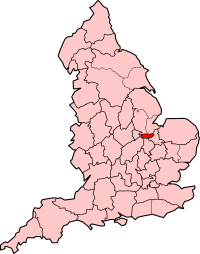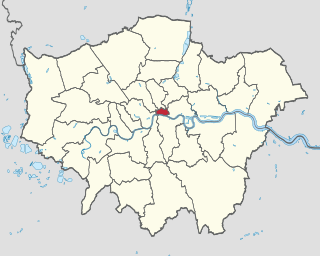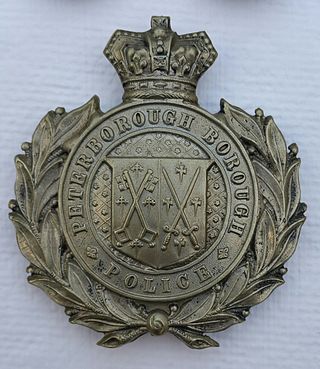
The Soke of Peterborough is a historic area of England associated with the City and Diocese of Peterborough, but considered part of Northamptonshire. The Soke was also described as the Liberty of Peterborough, or Nassaburgh hundred, and comprised, besides Peterborough, about thirty parishes.

Huntingdon and Peterborough was a short-lived administrative and geographical county in East Anglia in the United Kingdom. It existed from 1965 to 1974, when it became part of Cambridgeshire.

The City of London Police is the territorial police force responsible for law enforcement within the City of London, England, including the Middle and Inner Temples. The force responsible for law enforcement within the remainder of the London region, outside the city, is the much larger Metropolitan Police, a separate organisation. The City of London, which is now primarily a financial business district with a small resident population but a large commuting workforce, is the historic core of London, and has an administrative history distinct from that of the rest of the metropolis, of which its separate police force is one manifestation.

Cambridgeshire and Isle of Ely was, from 1965 to 1974, an administrative and geographical county in East Anglia in the United Kingdom. In 1974 it became part of an enlarged Cambridgeshire.
Police ranks are a system of hierarchical relationships in police organisations. The rank system defines authority and responsibility in a police organisation, and affects the culture within the police force. Usually, uniforms denote the bearer's rank by particular insignia affixed to the uniforms.

Cambridgeshire Constabulary is the local territorial police force that covers the county of Cambridgeshire and Peterborough unitary authority. It provides law enforcement and security for an area of 1,311 square miles (3,400 km2) and population of 856,000 people, in a predominantly rural county. The force of Cambridgeshire includes the cities of Cambridge, Ely and Peterborough, the market towns of Chatteris, Huntingdon, March, Ramsey, St Ives, St Neots, Whittlesey, and town and Port of Wisbech. Its emblem is a crowned Brunswick star containing the heraldic badge of Cambridgeshire County Council.

The Hampshire and Isle of Wight Constabulary is the territorial police force responsible for policing the counties of Hampshire and the Isle of Wight in South East England.

Sussex Police are the territorial police force responsible for policing in the whole of Sussex. Their jurisdiction covers the ceremonial counties of East Sussex and West Sussex. Their headquarters are in Malling House, Lewes, East Sussex.

The Isle of Man Constabulary is the national police service of the Isle of Man, an island of 85,000 inhabitants, situated approximately equidistant from Northern Ireland, Wales, Scotland and England.

The Mid-Anglia Constabulary was the territorial police force responsible for law enforcement in part of the East of England, from 1965 to 1974. It was created from the amalgamation of five forces. It was renamed Cambridgeshire Constabulary in 1974.

The custodian helmet is a type of helmet worn predominantly by male police officers in the United Kingdom, within England and Wales, and certain other places around the world. First used by the Metropolitan Police in London in 1863, the BBC labelled the custodian helmet a "symbol of British law enforcement". They are worn by male constables and sergeants on foot patrol. A cultural icon, it has featured in films, TV series and other media involving British police.
Police uniforms and equipment in the United Kingdom vary enormously per force or service, and different uniforms and equipment is used for different situations. Both what is worn and what is carried have varied considerably from the inception of the earliest recognisable mainstream police services in the early 19th century. As various laws in the mid-19th century standardised policing in the United Kingdom, so too were uniforms and equipment. From a variety of home grown uniforms, bicycles, swords and pistols the British police force evolved in look and equipment through the long coats and top hat, to the recognisable modern uniform of a white shirt, black tie, reflective jackets, body armour, and the battenburg-marked vehicles, to the present-day Airwave Solutions radios, electric vehicles and tasers.

Peterborough City Council is the local authority for Peterborough in the East of England. It is a unitary authority, having the powers of a non-metropolitan county and district council combined. The City was incorporated as a municipal borough in 1874; from 1888, it fell within the jurisdiction of the Soke of Peterborough county council and from 1965, Huntingdon and Peterborough county council. In 1974, it was replaced by a wholly new non-metropolitan district, broadly corresponding to the Soke, in the new enlarged Cambridgeshire. In 1998, Peterborough became independent of Cambridgeshire as a unitary authority, but the city continues to form part of that county for ceremonial purposes as defined by the Lieutenancies Act 1997.

The Police Act 1946 was an Act of Parliament of the Parliament of the United Kingdom that provided for the amalgamation of smaller borough police forces with county constabularies in England and Wales, allowed for the merger of county forces in certain circumstances and changed the boundaries of the Metropolitan Police District.

Sillitoe tartan is the nickname given to the distinctive black-and-white checkered pattern, correctly known as dicing, which was originally associated with the police in Scotland. It later gained widespread use in the rest of the United Kingdom and overseas, notably in Australia and New Zealand, as well as Chicago and Pittsburgh in the United States. It is used occasionally elsewhere, including by some Spanish municipal police and in parts of Canada, where it is limited to auxiliary police services.
The City of London market constabularies are three small constabularies responsible for security at Billingsgate, New Spitalfields and Smithfield markets run by the City of London Corporation.
Police uniforms in the United States vary widely due to the nation's tradition of highly decentralized law enforcement. Over time, however, a number of general conventions and styles have become representative of American police fashion. Police officers wear uniforms to deter crime by establishing a visible presence while on patrol, to make themselves easily identifiable to non-police officers or to their colleagues who require assistance, and to quickly identify each other at crime scenes for ease of coordination.
Cambridge City Police was the territorial police force responsible for law enforcement in Cambridge, England, from 1836 to 1965. From its creation until April 1951 it was known as Cambridge Borough Police. It subsequently merged with four other police forces to become what is known today as Cambridgeshire Constabulary.

The Peterborough City/Borough Police force was responsible for law enforcement in Peterborough, England, from 16 June 1874 to 1 April 1947, at which point it was merged with the Liberty of Peterborough Constabulary to form the Peterborough Combined Police.
The Liberty of Peterborough Constabulary was the territorial police force responsible for law enforcement surrounding 'The Soke of Peterborough', England, from 1856 to 1947. It was initially controlled by the Chief Constable of Northamptonshire Captain Henry Lambert Bayly 1857 - 1876. The constabulary had its headquarters in the old gaol behind the Sessions House on Thorpe Road in Peterborough.
Booklet Commemorating 100 years of service of THE PETERBOROUGH POLICE 1857–1957. And The OFFICIAL OPENING OF THE NEW POLICE HEADQUARTERS Bridge Street Peterborough. Printed by the 'Peterborough Standard' 10/10a Church Street Peterborough. Commemorating Booklet PDF



















